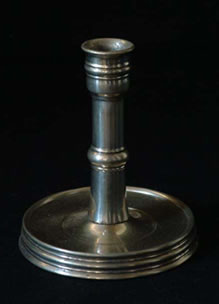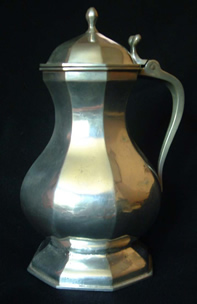Domestic Pewter
In this section of the shop can be found a small selection of the many types of pewter to be found in the medieval house.
Although the Romans made extensive use of pewter it seems that it fell largely out of use until at least the 11th century. For the next 200 years or so, pewter was largely confined to use for ecclesiastical purposes for which its high value and subsequent prestige was desirable. Over the centuries the production of pewter vessels developed, and as the items became more affordable, pewter began to find its way into domestic environments. Throughout the 13th and 14th centuries only homes of high status would have been able to afford pewter, and indeed it was not until the late 15th century that cheaper imported tin lowered the price to an extent that pewter began to find its way into more ordinary homes. From the mid 16th century, records show that pewter was in use in half the households of England.
The manufacture of pewter in the medieval period was highly organised, and indeed the London Pewterer's Guild was granted a royal charter in 1473, which gave it the right to control the craft throughout the whole country. Records of seizures of sub-standard goods and fines on pewterers' survive in sufficient quantity to suggest that the guild rigidly enforced its standards. English pewter was highly regarded throughout the period and its export was a major industry.


The production methods employed by pewterers' changed quite radically throughout the medieval period. Up until the 14th century, vessels were produced by the lost wax method, whereby the desired shape was produced in wax around a clay core and then completely encased in more clay. The wax was then melted out and replaced by molten pewter. The rough shape was then placed on a lathe for finishing. The disadvantage of this method was the fact that each item had to be made completely from scratch with the pattern being destroyed each time. A major development was the introduction of permanent bronze moulds in the late 14th century. Although these moulds were very expensive to make, they had the advantage that they would last for many years, and, for the first time, allowed large items to be partly mass produced. The moulds produced a rough casting which, as with the lost wax method, had to be turned on a lathe and polished to give a good finish.

Spoons
In the later medieval period spoons were produced in a variety of materials; wood or horn for the poorer classes, silver or silver gilt for the wealthy, and pewter or latten (similar to brass) for everyone else. Pewter and latten spoons often follow similar designs and while a latten spoons would have been stronger, pewter would have had the advantage in that it could be polished to imitate silver. You will notice that two of our replica spoons have brass knops (the knop is the decorative finial), this again appears to be a form of imitation as it is known that some silver spoons were manufactured with gilded knops.
If using one of our spoons for re-enactment it should be remembered that pewter is a relatively weak metal and therefore your spoon should be used with care. If used simply for lifting food from the bowl then a pewter spoon is perfectly strong enough, if however it is used for cutting through tough food then it will inevitably break or bend – just as the originals would have done if misused!
As with all pewter never put your spoon in a dishwasher.




